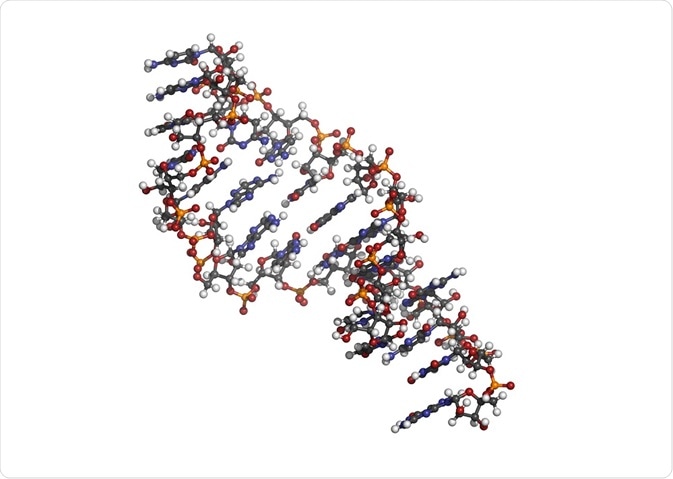RNA interference is a biological process that has evolved with the evolution of mammals and plays an important role in transient and long-term blocking of protein expression. Short Hairpin RNA (shRNA) interference has many therapeutic applications, and research is still ongoing into new areas of focus.
Skip to:
 Micro RNA (miRNA, hsa-miR-133a) structure, computer model. (molekuul_be | Shutterstock).
Micro RNA (miRNA, hsa-miR-133a) structure, computer model. (molekuul_be | Shutterstock).
Short hairpin RNA (shRNA) synthesis
Short hairpin RNA (shRNA) are produced in the nucleus of transduced or transfected cells which lead to the formation of hairpin structures. These hairpin structures make a loop by the pairing of sense and antisense strands. These strands are then connected to each other by unpaired nucleotides.
RNA polymerase II or III promoters are involved in the production of shRNAs that have defined 5´ and 3´ ends. Bacterial or viral vectors are used to introduce shRNAs into the nuclei of the targeted cells, which then integrate into the genome.
Viral delivery of shRNA is very useful for persistent suppression of a target gene. Some of the commonly used viral vector systems are adenovectors, adeno-associated virus vectors, retrovirus vectors, lentivirus vectors, baculovirus, replicating virus, and so on.
The loop structure of shRNA is used to prepare small interfering RNA (siRNA) sequences that mediate targeted knockdown of gene expression. shRNA is converted into siRNA by the same RNA interference (RNAi) machinery that is involved in the processing of microRNAs (miRNAs).
Delivering shRNA into target cells
Delivery of such RNAi therapeutics can be ex vivo or systemic. Ex vivo delivery involves the extraction and culture of cells such as monocytes, stem cells, or tumor cells from the patient. These cells are then transfected with siRNA or infected with shRNA to express lentiviruses.
In the case of monocytes, the cells are allowed to differentiate into dendritic cells while tumor cells are irradiated. After modification, these cells are injected back into the patient. Systemic delivery of RNAi therapeutics is carried out using the intravenous, ophthalmic (intravitreal), oral, or inhalation route.
Therapeutic applications of shRNA
shRNAs have been used to treat prostate cancer, melanoma, and neurogenerative diseases and is being carefully studied for its use in long-term regulation of target gene in other chronic diseases.
A trial by Huang et al on a murine model studied the use of shRNA in myocardial ischemia by targeting the prolyl hydroxylase-2 (PHD2) protein. Non-invasive molecular imaging of the mouse confirmed that inhibition of PHD2 by shRNA led to a marked improvement in angiogenesis.
The study also observed that the expression of shRNA is consistent when two H1 promoters drive the sense and antisense fragments of shRNA. These sense and antisense fragments are responsible for the knocking down effects that leads to down-regulation of the PHD2 gene in the mouse. PHD2 downregulation, in turn, activates downstream angiogenic proteins as well as genes involved in the hypoxia response pathway.
Studies have also shown the ability of retrovirally delivered shRNA in suppressing human immunodeficiency virus (HIV-1) infection for longer periods compared to other conventional HIV therapies.
ShRNA gene therapy has also been studied on non-obese immunocompromised mice that were injected with CD44+ CD24- cells, to observe its ability to suppress human breast tumors. It is known that CD44+ CD24- cells are the origin of breast tumors and therefore, CD44 down regulation can suppress tumor growth.
In a study by Pham et al, it was observed that a combination regimen of CD44 RNA lentiviral vector and doxorubicin led to strong inhibition of the tumor growth and was found to be safe. This offers a promising prospect in breast cancer treatment by targeting the cancer stem cells.
Realities of using shRNA as a therapeutic intervention
Despite the therapeutic efficacy and versatility of shRNA, some of the studies have demonstrated that shRNAs were sometimes overexpressed leading to acute cytotoxicity, raising concerns of its use as a therapeutic tool. This toxicity arises due to the inherent instability of RNA and their potential immunogenic activity because of which an efficient delivery vehicle is of paramount importance to deliver RNA-based drugs to the targeted cells.
In the future, the use of bi-functional RNAi or chemical modification of RNAi therapeutics may open up the opportunity for greater potency and safety of shRNAs and increase the probability for multi-target therapies.
Sources
- O’Keefe, E. P. (2019). siRNAs and shRNAs: Tools for Protein Knockdown by Gene Silencing. Matter Methods. dx.doi.org/10.13070/mm.en.3.197.
- Tsujiuchi T, Miller AD, Wakabayashi T et al. Chapter 27 - RNA Interference Therapeutics for Tumor Therapy: Promising Work in Progress. Gene therapy of Cancer. 2014:393-408. sciencedirect.com/topics/neuroscience/small-hairpin-rna
- Xiang S, Fruehauf J et al. Short hairpin RNA–expressing bacteria elicit RNA interference in mammals. Nature Biotechnology. 2006;24:697-702. nature.com/articles/nbt1211
- Ross JJ. Expression Strategies for Short Hairpin RNA Interference Triggers. Human Gene Therapy. 2008 Apr;19(4). doi.org/10.1089/hum.2008.026.
- Sliva K and Schinerle. Selective gene silencing by viral delivery of short hairpin RNA. Virology Journal. 2010;7:48. virologyj.biomedcentral.com.
- Rao DD, Vorhies JS, Senzer N et al. siRNA vs. shRNA: Similarities and differences
- sciencedirect.com/science/article/pii/S0169409X09000969. Advance Drug Delivery Reviews. 2009 Jul;61(9):746-59.
- Giering JC, Grimm D, Storm TA, et al. Expression of shRNA From a Tissue-specific pol II Promoter Is an Effective and Safe RNAi Therapeutic. Molecular Therapy. 2008;16(9). 1630-6. sciencedirect.com/science/article/pii/S1525001616320627.
- Burnett JC, Rossi JJ, and Tiemann K. Current Progress of siRNA/shRNA Therapeutics in Clinical Trials. Biotechnol J. 2011 Sep;6(9):113—46. ncbi.nlm.nih.gov/pmc/articles/PMC3388104/.
- Huang M, Chan DA, Jia F, et al. Short Hairpin RNA Interference Therapy for Ischemic Heart Disease. 2008 Sep;118:S226-33. doi/full/10.1161/CIRCULATIONAHA.107.760785.
- Burnett J and Rossi J. RNA-Based Therapeutics: Current Progress and Future Prospects. Chemistry and Biology. 2012 Jan;19(1):60-71. sciencedirect.com/science/article/pii/S1074552111004595.
- Yamagishi M, Ishida T, Miyake A et al. Retroviral delivery of promoter-targeted shRNA induces long-term silencing of HIV-1 transcription. Microbes and infection. 2009 Apr;11(4):500-8. sciencedirect.com/science/article/pii/S1286457909000185.
- Pham PV, Vu NB, Duong TT et al. Suppression of human breast tumors in NOD/SCID mice by CD44 shRNA gene therapy combined with doxorubicin treatment. Onco Targets Ther.2012;5:77-84. ncbi.nlm.nih.gov/pmc/articles/PMC3358118/.
Further Reading